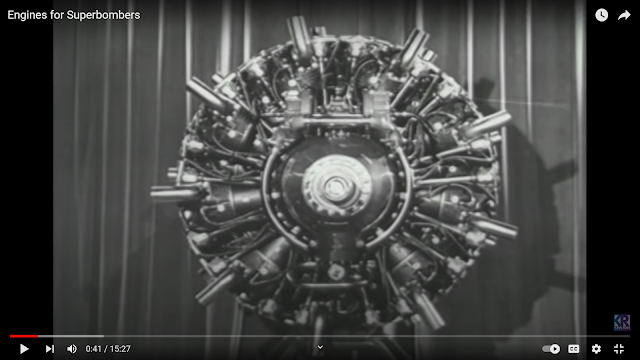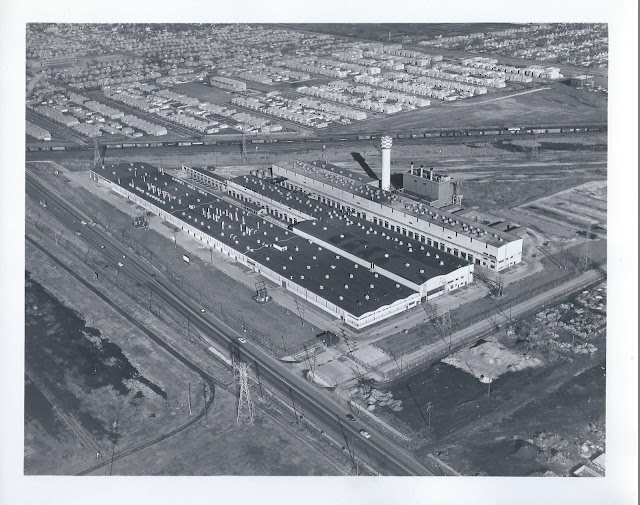An alternative title could be (Tootsie Roll+Ford City Mall)/Ford/Tucker/Dodge Plant in Chicago, IL.
 |
| 15:27 video @ 0:41 The Write R-3350 radial 18-cylinder, 2,200hp engine powered the B-29 Superfortress Bomber. From 1942-44, Dodge built a plant that was designed to build 1,600 engines a month. |
 |
| @ 1:13 The engine consisted of two 9-cylinder banks. 30,000 people worked here during its peak production. [14:39] |
 |
| MattStoneCars via FRRaP [This building was the office building that fronted Cicero Avenue. Most of that land is now a parking lot.] Buildings were built on a 500 acre "green field" that enclosed 6 million square feet or almost 140 acres. "It was the world's largest building at the time." At the end of WWII, production stopped and the machine equipment was sold off as military surplus. Preston Tucker then leased the facilities to design and produce his 1948 "Torpedo." But after just 52 cars were built, the plant was closed in 1949. [I've seen the claim of the "world's largest" in several sources. But I don't know if they mean the big building or all of the buildings. This article claims that the B29 was built here. That is wrong. It was the engine that was built here. The B-29s were evidently built in Boing's Kansas City plant. 4000 airplanes were built. Five engines were built for every airplane so that there would be spares. 5*4000*18=360,000 cylinders.] |
Dan Nocchi posted five photos with the comment:
In order to build his dream car, Tucker needed a place to begin working. An old Dodge plant in Chicago caught his eye. He leased the plant and rapidly began building the Tucker ’48 prototype. The plant itself covered 475 acres, but the main building covered 93 acres.Too bad the big three and the feds shut him down!
Thomas Conforti: If the big three hadn't rigged things against him out of fear of the superiority of the Tucker over their cars. He probably would have been the biggest. All the lies about him that still exist today are a joke.
 |
| 1 |
 |
| 2 |
 |
| 3 |
 |
| 4 |
 |
| 5 |
 |
| Eliseo Carrillo posted The assembly line for Tucker 48 automobile engines at the Chicago plant in 1948. Steven Cutler: Tucker bought Franklin Motors for their air cooled engines made for Bell Helicopters. They switched all production for the 52 cars they produced ignoring the government contracts they had to produce helicopters which could have been a cash cow for the cash strapped company. Ryan Tuttle: Tucker bought the Franklin engine company which was going into receivership. The had an air cooled vertical flat 6. Tucker modified the flat six to horizontal added water jackets with intake runs and a down draft carburetor. The Franklin motor did well in testing and propelled the 48 Tucker to over 120mph. |
After Tucker, Ford used the plant to make a different airplane engine.
 |
| David M Laz posted A view of the biggest industrial plant in the world, the Dodge Chicago Plant at 75th and Pulaski Road on Sept. 9, 1945. By 1950, the Ford Motor company would be making 28 cylinder Pratt and Whitney Wasp Major engines for use in Air Force planes. — Chicago Tribune historical photo |
 |
| 1953 Englewood Quad @ 24,000 |
In June 1942, the first building erected was the tool shop (the red rectangle in the northwest corner of the campus). "Over a million-and-half tools, jigs and fixtures were needed." And then the office buildings (orange) were built so the initial staff in Detroit could move to the location. On the opposite side of the campus, a die shop and forge division was built (yellow). An aluminum foundry was built to make the cylinder heads (dark blue) and a magnesium foundry was built to make the required magnesium castings (light blue). The big building (green) was for machining, assembly and testing. The parking lot (purple) could hold 13,000 cars. [@ 1:42]
 |
| 1953 Englewood Quad @ 24,000 plus Paint |
This is just the forging part of the complex and this part did not become Ford City.
 |
| James Stein posted Ford City 1960, photo scanned from my dad's collection. Jim Smith: My grandfather worked for Ford aircraft engine until they closed the plant in '59. |
Some of the forge buildings are still standing, but the smokestack has been truncated.
 |
| 3D Satellite |
Three photos posted by Gail Bob McCabe.
 |
| 1 |
 |
| 2 |
 |
| 3 |
So Ford vacated the buildings in 1959. [Jim Smith's comment on James Stein's post above.] Now I became confused because some Facebook comments say the building became Ford City Mall and other comments say it became Tootsie Roll. By looking at some topo maps, I concluded that both comments are right. The southern part of the big building was torn down to make way for the mall. Tootsie Roll moved into the northern part of the building in 1967 [The date is from a Thomas F Tedesco's comment on a post].
 |
| 1972 Englewood Quad @ 24,000 |
I came across the following two posts about Tootsie Roll in two days, and that is what motivated me to dig into the history of this building.
.jpg) |
| Thomas Cook posted Driving past Tootsie Roll today and I always wonder why the building was built like that and what those structures are/were for? [I presume the concrete structures above the roof were part of the test stands. More than 13,000 parts went into an engine. Then an engine ran on one of the 44 test stands driving a generator for four house at various speeds. (Testing generated about $25,000 of electricity each month.) Then an engine was taken apart so that all of the parts could be inspected! Then the engine was reassembled and had a final test. [11:52]] |
Thomas Cook was driving down 72nd Street.
 |
| Street View |
 |
| Historic Chicago posted Inside the Tootsie Roll Factory in Chicago. (1960s) [Many comments referenced a I Love Lucy show and some comments mentioned the beehive hairdo.] Heather Iffland: My friend and former coworker from another job is the current SQF Practitioner at Tootsie Roll. It used to be an airplane factory during WW2. It’s over a million square feet. He says they have a golf cart to get around. An SQF audit at my work takes a day and a half for 2 buildings and about 150,000 sq feet of building. Their audit takes 5 days. [I Googled SQF Practitioner. There were a lot of results about SQF training and certification. I finally found "Safe Quality Food (SQF)." The code is up to Edition 9.] Colleen Blackburn shared |
When I looked at the former magnesium foundry building, I thought it had been replaced because it looks rather modern. But when I watched the video I realized that the architect did build some rather modern looking buildings. So now I believe that this is one of the original buildings. This "little" building looks rather large.
 |
| Street View |
No comments:
Post a Comment